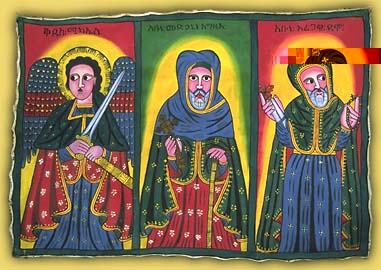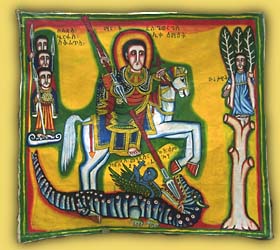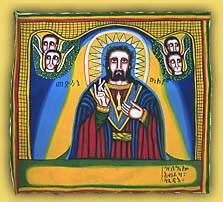|
Important as the seed-bed of Ethiopian Christianity - and as the capital
of the Ethiopian empire from the first until approximately the tenth century
AD - Axum's interest in terms of our project was nevertheless much broader
than this. Here, I read, we would come across many imposing pre-Christian
ruins of great archaeological merit (including the remains of several immense
palaces), and also - still well preserved - the monuments for which the city
was best known: its ancient obelisks, some more than two thousand years old,
attesting to a high level of advancement in art and architecture at a date
far earlier than that of any other civilization in sub-Saharan Africa. Nor
were such physical artefacts the only witnesses to Axum's unique stature.
To
my astonishment, the reference works I had with me reported that according to
Ethiopian legends the Ark of the Covenant was kept here in a small chapel
adjacent to an especially sacred church. The legends were connected to
Ethiopia's claim to have been the realm of the biblical Queen of Sheba but
were generally dismissed by historians as preposterous fictions.
Having only recently seen the first Indiana Jones movie, Raiders of the
Lost Ark, I was naturally intrigued by the possibility - however remote -
that the most precious and mystical relic of Old Testament times, a relic
believed to have been lost for almost three thousand years, might actually
rest in the city I was about to visit. I therefore decided that I would not
leave without learning more about this strange tradition and I looked down
with renewed interest when the captain announced that Axum was directly
beneath us.
The DC3'S descent to the narrow runway far below was unorthodox in the
extreme - and quite alarming. Instead of the usual long, low and slow
approach, the pilot brought the plane down very fast from a considerable
altitude in a tight corkscrew pattern that kept us at all times directly
above the town. This, one of the military men riding with us explained, was
so as to minimize the time that we would be a target for snipers in the
surrounding hills. I remembered what the Zambians had said about regularly
getting hit by machine-gun fire when landing at Axum and prayed silently that
this would not happen to us. It was an unpleasant feeling to be strapped into
a flimsy seat in a narrow tube of metal hundreds of feet above the ground and
to wonder whether, at any moment, bullets were going to start plunking
through the cabin floor and walls.
Fortunately nothing so bad happened that morning and we touched down
safely. I remember the red gravel of the strip, the dust that flew up as the
wheels made contact, and the sight of large numbers of Ethiopian soldiers -
all armed to the teeth and dressed in combat fatigues - staring at us
intently as we taxied to a halt. I noticed other things as well: trenches had
been dug on both sides of the runway and there were numerous pits, covered
with camouflage netting, out of which protruded the barrels of heavy
artillery pieces. I recall several armoured personnel carriers lined up near
the tower and perhaps half-a-dozen Soviet tanks. Parked off to one side, on
the apron, there were also two Mi-24 helicopter gunships with rocket pods
visible beneath their stubby stabilizing fins.
From the beginning to the end of our visit, Axum never for a second shed
the jittery and watchful atmosphere of a city under siege. We were permitted
to stay only one night but we felt as though our time there was drawn-out,
protracted, almost infinite.

Return to Ethiopia Index
Initiation: 1986 |
A great mystery of the Bible |
1983: a country at war
Into Axum |
Palaces, catacombs and obelisks |
The sanctuary chapel
|
|




